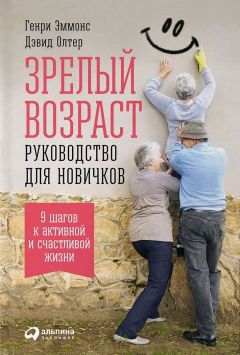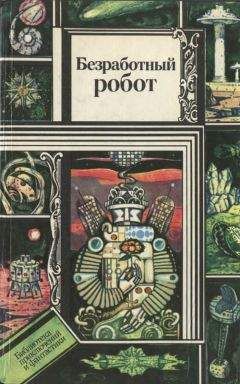Генри Эммонс - Зрелый возраст

Помощь проекту
Зрелый возраст читать книгу онлайн
166. P. Greenwood, Nurturing the Older Brain and Mind (Cambridge, MA: MIT Press,
2012).
167. J. Singer, Memories that Matter (Oakland, CA: New Harbinger Publications, 2005).
9. Молодость мозга и оптимизм: шаг шестой168. D. Hecht, “The Neural Basis of Optimism and Pessimism.” Experimental Neurobiology 22, no. 3 (2013): 173-99.
169. A. Reading, Hope and Despair: How Perceptions of the Future Shape Human Behavior (Baltimore: The Johns Hopkins University Press, 2004), 3.
170. L. Abramson, M. Seligman, and J. Teasdale, “Learned Helplessness in Humans: Critique and Reformulation,” Journal of Abnormal Psychology 87, no. 1 (1978): 49-74.
171. T. Sharot et al., “Dopamine Enhances Expectation of Pleasure in Humans," Current Biology (2009), doi:10.1016/j.cub.2009.10.025.
172. T. Sharot, C. Korn, and R.J. Dolan, “How Unrealistic Optimism Is Maintained in the Face of Reality," Nature Neuroscience 14 (2011): 1475-79.
173. C. Moutsiana, N. Garrett, R.C. Clarke, R.B. Lotto, S.J. Blakemore, and T. Sharot, “Human Development of the Ability to Learn from Bad News, Proceedings of the National Academy of Sciences 110, no. 41 (2013): 16396-401.
174. R. Hanson and R. Mendius, Buddha's Brain: Practical Neuroscience of Happiness, Love and Wisdom (Oakland, CA: New Harbinger Publications, 2009).
175. C. Korn, T. Sharot, H. Walter, H.R. Heekeren, and R.J. Dolan, “Depression Is Related to an Absence of Optimistically Biased Belief Updating about Future Life Events,” Psychological Medicine 44 (2014): 579-92.
176. R. Chowdhury, T. Sharot, T. Wolfe, E. Diizel, and R.J. Dolan, “Optimistic Update Bias Increases in Older Age,” Psychological Medicine 4 (2013): 1-10.
177. M. Gallagher, S. Lopez, and S. Pressman, “Optimism Is Universal: Exploring the Presence and Benefits of Optimism in a Representative Sample of the World,” Journal of Personality 81, no. 5 (2013): 429-40.
178. R. Chowdhury, T. Sharot, T. Wolfe, E. Diizel, and R.J. Dolan, “Optimistic Update Bias Increases in Older Age.”
179. S.H. Kim, B. Cornwell, and S.E. Kim, “Individual Differences in Emotion Regulation and Hemispheric Metabolic Asymmetry,” Biological Psychology 89 (2012): 382-86.
180. R. Davidson, “Affective Neuroscience and Psychophysiology: Toward a Synthesis,” Psychophysiology 40, no. 5 (2003): 655-65.
181. K. Kakolewski et al., “Laterality Word Valence, and Visual Attention: A Comparison of Depressed and Non-Depressed Individuals,” International Journal of Psychophysiology 34 (1999): 283-92.
182. M. Seligman, Learned Optimism: How to Change Your Mind and Your Life, 2nd ed. (New York: Pocket Books, 1998).
183. M. Yapko, Depression Is Contagious (New York: Free Press, 2009).
184. A. Leaver, J. Van Lare, B. Zielinski, A. Halpern, and J. Rauschecker, “Brain Activation during Anticipation of Sound Sequences,” Journal of Neuroscience 29. no. 8 (2009), 2477, doi:10.1523/JNEUROSCI.4921-08.2009.
185. К. Walker and A. King, “Auditory Neuroscience: Temporal Anticipation Enhances Cortical Processing,” Current Biology 12:21, no. 7 (2011), R251-3, doi:10.1016/j. cub.2011.02.022.
186. R. Sapolsky, “Are Humans Just Another Primate?” Pritzker Lecture, California Academy of Sciences, Feb. 15,2011: retrieved Apr. 20,2014, from http://video. calacademy.org/details/349.
10. Мозг и умение сопереживать: шаг седьмой187. J. Crabtree, “Agnes the Ageing Suit,"JFT Magazine, July 22,2011: retrieved May 6, 2014, from www.ft.com/cms/s/2/lfedleee-b34b-lle0-9af2-00144feabdc0.html.
188. P. Bailey and J. Henry, “Growing Less Empathic with Age: Disinhibition of the Self-Perspective,” Journal of Gerontology 63B, no. 4 (2008): 19-26.
189. G. Labouvie-Vief et al., “Dynamic Emotion-Cognition Interactions in Development: Arousal, Stress, and the Processing of Affect,” in Aging and Cognition, ed. H.B. Bosworth and C. Hertzog (Washington, DC: American Psychological Association, 2009).
190. W. Cannon, “The James-Lange Theory of Emotions: A Critical Examination and an Alternative Theory,” The American Journal of Psychology 39 (1927): 106-24.
191. G. Rizzolatti et al., “Functional Organization of Inferior Area 6 in the Macaque Monkey: Area 5 and the Control of Distal Movements,” Experimental Brain Research 71 (1998): 491-507.
192. V. Gallese and A. Goldman, “Mirror Neurons and the Stimulation Theory of Mind-Reading,” Trends in Cognitive Sciences 2 (1998): 493-501.
193. T. Insel and L. Young, “The Neurobiology of Attachment,” Nature Reviews: Neuroscience 2 (2001): 129-36.
194. A. Schore, “Effects of a Secure Attachment Relationship on Right Brain Development, Affect Regulation and Infant Mental Health,” Infant Mental Health Journal 1-2 (2001): 7-66.
195. A. Schore, “Attachment and Regulation of the Right Brain,” Attachment and Human Development 2, no. 1 (2000): 23-47.
196. A. Schore, “Paradigm Shift: The Right Brain and the Relational Unconscious,” American Psychological Association, invited speaker, lecture conducted for Plenary Session at the American Psychological Association Annual Convention, Toronto, Canada, Aug. 8,2009.
197. A. Schore, “Effects of a Secure Attachment Relationship.”
198. A. Schore, “Attachment and Regulation of the Right Brain.”
199. A. Schore, “Paradigm Shift.”
200. W.A. Collins and L.A. Sroufe, “Capacity for Intimate Relationships: A Developmental Construction,” in W. Furman, B.B. Brown, and C. Feiring, eds., The Development of Romantic Relationships in Adolescence (New York: Cambridge University Press, 1999).
201. М. Solomon, “Emotion in Romantic Partners: Intimacy Found, Intimacy Lost, Intimacy Reclaimed,” in D. Fosha, D, Siegel, and M. Solomon, eds., The Healing Power of Emotion: Affective Neuroscience, Development and Clinical Practice (New York: W.W. Norton, 2009).
202. M. Lucas, Rewire Your Brain for Love: Creating Vibrant Relationships Using the Science of Mindfulness (Carlsbad, CA: Hay House Publishing, 2012).
203. J. Sze et al., “Greater Emotional Empathy and Prosocial Behavior in Late Life," Emotion 12, no. 5 (2012): 1129-40.
204. R. Levenson, “Emotion and Emotion Regulation," in Changing Emotions, ed. D. Hermans, B. Rime, and B. Mesquita (New York: Psychology Press, 2013), 105-12.
205. G. Labouvie-Vief, Psyche and Eros: Mind and Gender in The Life Course (New York: Cambridge University Press, 1995).
206. B. Kok et al., “How Positive Emotions Build Physical Health: Perceived Positive Social Connections Account for Upward Spiral between Positive Emotions and Vagal Tone,” Psychological Science 24, no. 7 (2013): 1123-32.
207. C.D. Batson et al., eds., “Empathy and Altruism,” Oxford Handbook of Positive Psychology, 2nd ed. (New York: Oxford University Press, 2009).
208. B. Schwartz, Rippling: How Social Entrepreneurs Spread Innovation throughout the World (New York: John Wiley & Sons, 2012).
209. T. Hacker, “Building Empathy Builds Society,” The Seattle Times, Jan. 28, 2013.
210. J. Eakin, Living Autobiographically: How We Create Identity in Narrative (Ithaca: Cornell University Press, 2008).
211. P. Eriksson and L. Wallin, “Functional Consequences of Stress-Related Suppression of Adult Hippocampal Neurogenesis: A Novel Hypothesis on the Neurobiology of Burnout,” Acta Neurologica Scandinavia 110, no. 5 (2004): 275-80.
212. J.D. Bremner, Does Stress Damage the Brain? (New York: W.W. Norton & Co.,
2002).
213. M. Crockett et al., “Serotonin Selectively Influences Moral Judgment and Behavior through Effects on Harm Aversion," Proceedings of The National Academy of Sciences 107, no. 40 (2010), retrieved May 19, 2014, doi:10.1073/ pnas.1009396107.
214. J.T. Cacioppo et al., “Social Neuroscience: Progress and Implications for Mental Health,” Perspectives on Psychological Science 2, no. 2 (2007): 99-123.
215. C. Yamal and X. Qian, “Older-Adult playfulness: An Innovative Construct and Measurement for Healthy Aging Research,” American Journal of Play 4, no. 1 (2011): 52-78.
216. E.Y. Cornwell and L.J. Waite, “Social Disconnectedness, Perceived Isolation, and Health among Older Adults,'"Journal of Health and Social Behavior 50, no. 1 (2009): 31-48.
217. T. Schmid, Promoting Health through Creativity: For Professionals in Health, Arts and Education (London, England: Whurr Publishers Ltd., 2005).
11. Мозг и потребность в общении: шаг восьмой218. С. Pasquaretta et al., “Social Networks in Primates: Smart and Tolerant Species Have More Efficient Networks,” Scientific Reports 4, Article number 7600 (Dec. 2014), doi:10.1038/srep07600.
219. К. M. Kendrick, “The Neurobiology of Social Bonds,"Journal of Neuroendocrinology 16. no. 12 (Dec 2004): 1007-8.
220. P.L. Wachtel, Relational Therapy and the Practice of Psychotherapy (New York: Guilford Publishing, 2008).
221. L. Cozolino, The Neuroscience of Human Relationships: Attachment and the Developing Social Brain (New York: W.W. Norton, 2006).
222. D. Wallin, Attachment in Psychotherapy (New York: Guilford Publishing, 2007), 101.
223. L.M. Matire and M.M. Franks, “The Role of Social Networks in Adult Health: Introduction to the Special Issue,” Health Psychology 33, no. 6 (2014), 501-4.
224. J.K. Kiecolt-Glaser and T.L. Newton, “Marriage and Health: His and Hers.” Psychological Bulletin 127 (2001): 472-503.
225. M.M. Franks et al., “I Will If You Will: Similarity in Health Behavior Change of Married Partners,” Health Education and Behavior 39 (2012): 324-31.
226. R.S. Sneed, and S. Cohen, “Negative Social Interactions and Incident Hypertension among Older Adults," Health Psychology 33 (2014): 554-65.
227. S.T. Cheng et al., “Physical and Social Activities Mediate the Associations between Social Network Types and Ventilator Function in Chinese Older Adults,” Health Psychology 33 (2014): 524-34.
228. J. Hollis, The Eden Project: In Search of the Magical Other (Toronto: Inner City Books, 1998), 13.
229. C.J. Jung, “Commentary on ‘The Secret of the Golden Flower,’" in Collected Works, vol.13. Alchemical Studies (UK: Routledge & Kegan Paul, 1967), 47-48.
230. U.S. Department of Health and Human Services, “Prevention Makes Common ‘Cents’ ”: http://aspe.hhs.gov/health/prevention/prevention.pdf (2003).
231. A. Golay et al., “Motivating for Change: A New Approach,” Service of Therapeutic Educationfor Chronic Diseases, Didactic Science Laboratory, Geneva, Switzerland, 2012.
232. N.L. Kerr and C.M. Kaufman-Gililand, “Communication, Commitment, and Cooperation in Social Dilemma,” Journal of Personality and Social Psychology 66. no. 3 (1994): 513-29.
233. K.M. Brethel-Haurwitz and A. A. Marsh, Geographical Differences in Subjective Well-Being Predict Extraordinary Altruism, Psychological Science 25, no. 3 (2014): 762-71.
234. V.E. Frankl, The Unheard Cry for Meaning: Psychotherapy and Humanism (New York: Simon & Schuster, 1978).
235. M. Freedman, Encore: Finding Work That Matters in the Second Half of Life (New York: Perseus Books Group, 2007).
236. W. Muller, How, Then, Shall We Live? (New York: Bantam, 1996).
237. M. Buber, I and Thou (New York: Charles Scribner’s Sons, 1970).
238. E. Renehan et al., “Healthy Aging Literature Review,” National Ageing Research Institute and Council on the Ageing, 2012, prepared for the Victoria, Australia, Department of Health, www.health.vic.gov.au/agedcare.
239. B. Cornwell, E.O. Laumann, and L.P. Schumm, “The Social Connectedness of Older Adults: A National Profile,” American Sociological Review 73, no. 2 (2008): 185-203.
240. Quoted from “Addressing Isolation among Older Adults: The Role of Social Connectedness in Healthy Aging,” report of The National Council on Aging, 2014, www.illuminage.com/webinars/presentations/webinar-052214.pdf.
241. C. A. Emlet and J.T. Moceri, “The Importance of Social Connectedness in Building Age-Friendly Communities,” Jowrra/ of Aging Research 2012, article ID173247,9 pages, http://dx.doi org/10.1155/2012/173247.
242. V. Toepoel, “Aging, Leisure, and Social Connectedness: How Could Leisure Help Reduce Social Isolation of Older People?” Social Indicators Research 113 (2013): 355-72.
243. D. Whyte, Everything Is Waitingfor You (Langley, WA: Many Rivers Press, 2003).
12. Жить настоящей жизнью: шаг девятый244. http://rabbidavidkominsky.com/tag/zusya/. Used with permission.
245. P. Palmer, Let Your Life Speak: Listening to the Voice of Vocation (New York: John Wiley & Sons, 2000).
246. Там же.
247. P. Nelson, There's A Hole in My Sidewalk (Hillsboro, OR: Beyond Words, 1993).
248. M. Oliver, “When Death Comes,” New and Selected Poems (Boston: Beacon Press, 2004).
249. S. Haldeman-Martz, ed., If I Had My Life to Live Over, I Would Pick More Daisies (Watsonville, CA: Papier-Mache Press, 2010).
250. W. Muller, A Life of Being, Having, and Doing Enough (New York: Harmony, 2011).

























